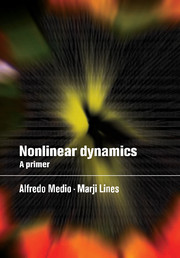Book contents
- Frontmatter
- Contents
- Preface
- 1 Statics and dynamics: some elementary concepts
- 2 Review of linear systems
- 3 Stability of fixed points
- 4 Invariant and attracting sets, periodic and quasiperiodic orbits
- 5 Local bifurcations
- 6 Chaotic sets and chaotic attractors
- 7 Characteristic exponents, fractals, homoclinic orbits
- 8 Transition to chaos
- 9 The ergodic approach
- 10 Deterministic systems and stochastic processes
- Further reading
- Bibliography
- Subject index
8 - Transition to chaos
Published online by Cambridge University Press: 14 May 2010
- Frontmatter
- Contents
- Preface
- 1 Statics and dynamics: some elementary concepts
- 2 Review of linear systems
- 3 Stability of fixed points
- 4 Invariant and attracting sets, periodic and quasiperiodic orbits
- 5 Local bifurcations
- 6 Chaotic sets and chaotic attractors
- 7 Characteristic exponents, fractals, homoclinic orbits
- 8 Transition to chaos
- 9 The ergodic approach
- 10 Deterministic systems and stochastic processes
- Further reading
- Bibliography
- Subject index
Summary
In chapter 5 we studied bifurcations, that is, qualitative changes in the orbit structures of dynamical systems, which take place when parameters are varied. In chapter 6 we discussed chaos and provided a precise characterisation of chaotic dynamics. In this chapter we take up again the question of transition in a system's behaviour, with a view to understanding how complex dynamics and chaos appear as parameters change. This problem is often discussed under the label ‘routes to chaos’. The present state of the art does not permit us to define the prerequisites of chaotic behaviour with sufficient precision and generality, and we do not have a complete and exhaustive list of all such possible routes. In what follows we limit our investigation to a small number of ‘canonical’ transitions to chaos which are most commonly encountered in applications. In our discussion we omit many technical details and refer the reader to the relevant references.
Period-doubling route to chaos
Although the period-doubling route to chaos could be discussed in a rather general framework (cf. Eckmann 1981, pp. 648–9), here we shall treat it in the context of noninvertible one-dimensional maps, because they provide an interesting topic per se and are by far the most common type of dynamical system encountered in applications. Before describing the period-doubling scenario in detail, we discuss some general results covering a broad class of one-dimensional maps.
- Type
- Chapter
- Information
- Nonlinear DynamicsA Primer, pp. 214 - 236Publisher: Cambridge University PressPrint publication year: 2001

